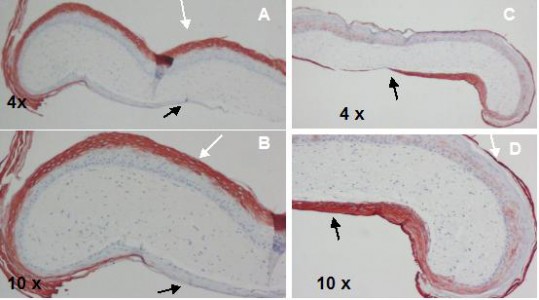Performance and analysis of epiboly by using bioengineered skin constructs in response to investigators’ test products, cells, as well as human tissue preparation for epiboly.
Epiboly refers to the migration of keratinocytes over certain surfaces, including endogenoussubstrates. We have previously published on the use of a living bilayered bioengineered skin construct (Organogenesis; Canton, MA) for this purpose. Other contructs can be used. The essay allows measurement of keratinocyte migration using epiboly and computerized photomicrographs. When punch biopsies (4-6 mm) of the construct are placed in tissue culture dishes DMEM (without FBS), the keratinocyte layer will migrate and envelop the underlying dermal construct over 72 hours. Our studies have indicated that the process can be accelerated by EGF, downregulated by TGF-β1, and blocked with neutralizing antibodies against vitronectin (epibolin). The identification of vitronectin as being crucial to this process had been previously described. The speed/extent of migration is quantified by histologic measurements validated in response to different culture conditions and therapeutic agents; thus, users of the core can make use of it to screen specific agents/cells of interest. Figure 2 shows the epithelial migration and some selected keratin markers in this model.

Fig. 1. White arrows point to mature top of a living bilayered construct (human foreskin keratinocytes over human dermal fibroblast in a bovine collagen matrix) that was injured by taking punch biopsies and placing them in DMEM).
K10 (left panels A and B) – Clear sparing of the migrating tongue of epithelium (black arrow). Results shown at 48-72 hrs, but the process of epiboly was already present by 24 hrs
K17 (right panels C and D) – Marked expression confined to the migrating edge of the epiboly (black arrow). Little or no expression is seen in the original, more differentiated portion of the construct.